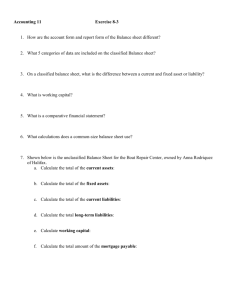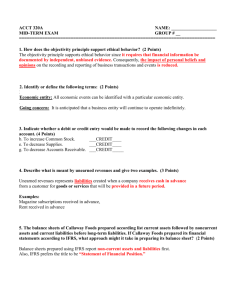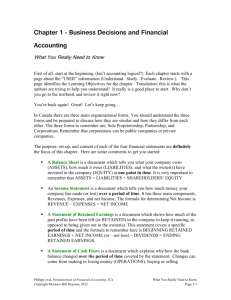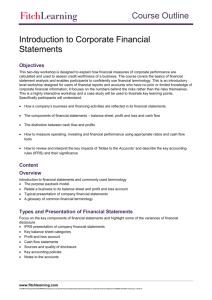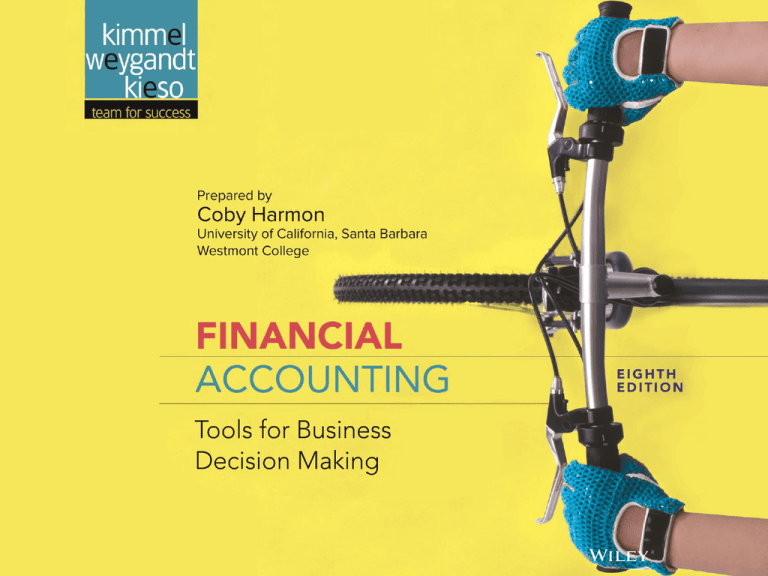
2-1
2
A Further Look at Financial
Statements
Kimmel ● Weygandt ● Kieso
Financial Accounting, Eighth Edition
2-2
CHAPTER OUTLINE
LEARNING OBJECTIVES
2-3
1
Identify the sections of a classified balance sheet.
2
Use ratios to evaluate a company’s profitability,
liquidity, and solvency.
3
Discuss financial reporting concepts.
LEARNING
OBJECTIVE
1
Identify the sections of a classified
balance sheet.
Presents a snapshot at a point in time.
To improve understanding, companies group similar
assets and similar liabilities together.
Standard Classifications
Assets
Current assets
Long-term investments
Property, plant, and equipment
Intangible assets
ILLUSTRATION 2-1
Standard balance sheet classifications
2-4
Liabilities and Stockholders’ Equity
Current liabilities
Long-term liabilities
Stockholders’ equity
LO 1
ILLUSTRATION 2-2
Classified balance sheet
2-5
LO 1
ILLUSTRATION 2-2
Classified balance sheet
2-6
LO 1
THE CLASSIFIED BALANCE SHEET
Current Assets
2-7
Assets that a company expects to convert to cash or
use up within one year or the operating cycle,
whichever is longer.
Operating cycle is the average time it takes from the
purchase of inventory, to the sale of goods, and then
to the collection of cash from customers.
Common types of current assets are (1) cash, (2)
investments, (3) receivables, (4) inventories, and (5)
prepaid expenses.
LO 1
THE CLASSIFIED BALANCE SHEET
Current Assets
Illustration 2-3
Current assets section
Companies list current asset accounts in the order they expect to
convert them into cash.
2-8
LO 1
THE CLASSIFIED BALANCE SHEET
Review Question
Cash, and other resources that are reasonably expected to
be realized in cash or sold or consumed in the business
within one year or the operating cycle, are called:
a. Current assets.
b. Intangible assets.
c. Long-term investments.
d. Property, plant, and equipment.
2-9
LO 1
THE CLASSIFIED BALANCE SHEET
Long-Term Investments
Investments in stocks and bonds of other corporations
that are held for more than one year.
Long-term assets such as land or buildings that a
company is not currently using in its operating activities.
Long-term notes receivable.
ILLUSTRATION 2-4
Long-term investments section
2-10
LO 1
THE CLASSIFIED BALANCE SHEET
Property, Plant, and Equipment
2-11
Long useful lives.
Currently used in operations.
Includes land, buildings, equipment, delivery vehicles,
and furniture.
Depreciation - allocating the cost of assets to a number
of years.
Accumulated depreciation - total amount of
depreciation expensed thus far in the asset’s life.
Alternative Terminology
Property, plant, and equipment is
sometimes called fixed assets or
plant assets.
LO 1
Property, Plant, and Equipment
ILLUSTRATION 2-5
Property, plant, and equipment section
2-12
LO 1
THE CLASSIFIED BALANCE SHEET
Intangible Assets
2-13
Assets that do not have physical
substance.
Includes goodwill, patents, copyrights,
and trademarks or trade names.
▼Helpful Hint
Sometimes intangible
assets are reported
under a broader
heading called “Other
assets.”
LO 1
THE CLASSIFIED BALANCE SHEET
Intangible Assets
ILLUSTRATION 2-6
Intangible assets section
Illustration 2-6
2-14
LO 1
THE CLASSIFIED BALANCE SHEET
Review Question
Patents and copyrights are
a. Current assets.
b. Intangible assets.
c. Long-term investments.
d. Property, plant, and equipment.
2-15
LO 1
DO IT!
1a
Assets Section of Classified Balance
Sheet
Baxter Hoffman recently received the following information
related to Hoffman Corporation’s December 31, 2017, balance
sheet.
Prepaid insurance $ 2,300
Cash
800
Equipment
10,700
Accounts receivable 1,100
Inventory
$3,400
Accumulated depreciation—
equipment
2,700
Prepare the assets section of Hoffman Corporation’s classified
balance sheet.
2-16
LO 1
Prepare the assets section of the classified balance sheet.
Prepaid insurance
Cash
Equipment
Accounts receivable
2-17
$ 2,300
800
10,700
1,100
Inventory
$3,400
Accumulated depreciation—
equipment
2,700
THE CLASSIFIED BALANCE SHEET
Current Liabilities
2-18
Obligations the company is to pay within the next year
or operating cycle, whichever is longer.
Common examples are accounts payable, salaries and
wages payable, notes payable, interest payable, and
income taxes payable.
Also included as current liabilities are current maturities
of long-term obligations—payments to be made within
the next year on long-term obligations.
LO 1
THE CLASSIFIED BALANCE SHEET
Current Liabilities
ILLUSTRATION 2-7
Current liabilities section
2-19
LO 1
THE CLASSIFIED BALANCE SHEET
Long-Term Liabilities
2-20
Obligations a company expects to pay after one year.
Include bonds payable, mortgages payable, long-term
notes payable, lease liabilities, and pension liabilities.
ILLUSTRATION 2-8
Long-term liabilities section
LO 1
THE CLASSIFIED BALANCE SHEET
Review Question
Which of the following is not a long-term liability?
a. Bonds payable.
b. Current maturities of long-term debt.
c. Long-term notes payable.
d. Mortgages payable.
2-21
LO 1
THE CLASSIFIED BALANCE SHEET
Stockholders’ Equity
Common stock - investments of assets into the business by
the stockholders.
Retained earnings - income retained for use in the business
Stockholders’ Equity section for Franklin Corporation
Illustration 2-2
2-22
LO 1
DO IT!
1b
Balance Sheet Classifications
Match each of the items to its proper balance sheet classification, shown below. If
the item would not appear on a balance sheet, use “NA.”
Current assets (CA)
Current liabilities (CL)
Long-term investments (LTI)
Long-term liabilities (LTL)
Property, plant, and equipment (PPE)
Stockholders’ equity (SE)
Intangible assets (IA)
Solution
CL
Salaries and wages payable
LTI
NA
Service revenue
PPE Equipment
CL
Interest payable
PPE Accumulated depreciation
IA
Goodwill
CA
Debt investments (short-term)
NA
Depreciation expense
SE
Retained earnings
CL
Unearned service revenue
LTL Mortgage payable
Investment in real estate
(due in 3 years)
2-23
LO 1
LEARNING
OBJECTIVE
2
Use ratios to evaluate a company’s
profitability, liquidity, and solvency.
Ratio Analysis
2-24
Ratio analysis expresses the relationship among
selected items of financial statement data.
A ratio expresses the mathematical relationship
between one quantity and another.
A single ratio by itself is not very meaningful.
LO 2
RATIO ANALYSIS
ILLUSTRATION 2-9
Financial ratio classifications
2-25
LO 2
USING THE INCOME STATEMENT
Illustration 2-10
ILLUSTRATION 2-10
Best Buy’s income statement
2-26
LO 2
Earnings per Share
Profitability
Ratio
Illustration: Earnings per share (EPS) measures the net income
earned on each share of common stock.
2-27
LO 2
USING THE INCOME STATEMENT
Review Question
For 2017 Stoneland Corporation reported net income
$26,000; net sales $400,000; and average shares
outstanding 6,000. There were preferred stock dividends of
$2,000. What was the 2017 earnings per share?
a. $4.00
b. $0.06
$26,000 - $2,000
c. $16.67
6,000
= $4.00
d. $66.67
2-28
LO 2
USING A
CLASSIFIED
BALANCE
SHEET
2-29
Illustration 2-12
Best Buy’s
balance sheet
USING A CLASSIFIED BALANCE SHEET
Liquidity—the ability to pay obligations expected to become
due within the next year or operating cycle.
Working capital is the difference between the amounts of
current assets and current liabilities.
ILLUSTRATION 2-13
Working capital
2-30
Best Buy had working capital in
2014 of $3,049 million ($10,485
million − $7,436 million).
LO 2
USING A CLASSIFIED BALANCE SHEET
Liquidity ratios measure the short-term ability to pay maturing
obligations and to meet unexpected needs for cash.
2014
ILLUSTRATION 2-14
Current ratio
2-31
For every dollar of current liabilities, Best
Buy has $1.41 of current assets.
LO 2
ACCOUNTING ACROSS THE ORGANIZATION
Can a Company Be Too Liquid?
There actually is a point where a company can be too liquid—that is, it can
have too much working capital. While it is important to be liquid enough to be
able to pay short-term bills as they come due, a company does not want to
tie up its cash in extra inventory or receivables that are not earning the
company money. By one estimate from the REL Consultancy Group, the
thousand largest U.S. companies had cumulative excess working capital of
$1.017 trillion in a recent year. This was an 18% increase, which REL said
represented a“ deterioration in the management of operations.” Given that
managers throughout a company are interested in improving profitability, it is
clear that they should have an eye toward managing working capital. They
need to aim for a “Goldilocks solution”—not too much, not too little, but just
right.
Source: Maxwell Murphy, “The Big Number,” Wall Street Journal (November
9, 2011).
2-32
LO 2
USING A CLASSIFIED BALANCE SHEET
Solvency—the ability to pay interest as it comes due and
to repay the balance of a debt due at its maturity.
Solvency ratios measure the ability of the company to
survive over a long period of time.
▼Helpful Hint Some users evaluate solvency
using a ratio of liabilities divided by stockholders’
equity. The higher this “debt to equity” ratio, the
lower is a company’s solvency.
2-33
LO 2
USING A CLASSIFIED BALANCE SHEET
Debt to assets ratio measures the percentage of total
financing provided by creditors rather than stockholders.
ILLUSTRATION 2-15
Debt to assets ratio
2-34
The 2014 ratio means that every dollar of
assets was financed by 72 cents of debt.
LO 2
INVESTOR INSIGHT
When Debt Is Good
Debt financing differs greatly across industries and companies.
Here are some debt to assets ratios for selected companies in a
recent year:
Debt to
Assets Ratio
2-35
Google
23%
Nike
41%
Microsoft
48%
ExxonMobil
48%
General Motors
74%
LO 2
USING THE STATEMENT OF CASH FLOWS
In the Statement of Cash Flows, cash provided by operating
activities fails to take into account that a company must invest
in new property, plant, and equipment and must maintain
dividends at current levels to satisfy investors.
Free cash flow describes the net cash provided by operating
activities after adjusting for capital expenditures and dividends
paid.
ILLUSTRATION 2-16
Free cash flow
2-36
LO 2
USING THE STATEMENT OF CASH FLOWS
Illustration: MPC produced and sold 10,000 personal computers this
year. It reported $100,000 cash provided by operating activities. In
order to maintain production at 10,000 computers, MPC invested
$15,000 in equipment. It chose to pay $5,000 in dividends.
Calculate free cash flow.
Cash provided by operating activities
Less: Expenditures on property, plant, and equipment
$100,000
-15,000
Dividends paid
5,000
Free cash flow
$ 80,000
2-37
LO 2
DO IT!
2 Ratio Analysis
The following information is available for Ozone Inc.
2017
Current assets
$ 88,000
Total assets
400,000
Current liabilities
40,000
Total liabilities
120,000
Net income
100,000
Net cash provided by operating activities 110,000
Preferred dividends
10,000
Common dividends
5,000
Expenditures on PP&E
45,000
Shares outstanding at beginning of year
Shares outstanding at end of year
2-38
60,000
120,000
2016
$ 60,800
341,000
38,000
150,000
50,000
70,000
10,000
2,500
20,000
40,000
60,000
LO 2
DO IT!
2 Ratio Analysis
(a) Compute earnings per share for 2017 and 2016 for Ozone.
Ozone’s primary competitor, Frost Corporation, had
earnings per share of $2 in 2017.
SOLUTION
Earnings per
share
2-39
LO 2
DO IT!
2 Ratio Analysis
(b) Compute the current ratio and debt to assets ratio for 2017.
SOLUTION
Current
Ratio
Debt to Assets
ratio
2-40
LO 2
DO IT!
2 Ratio Analysis
(b) Compute free cash flow for each year.
SOLUTION
2017
2016
Net cash provided by
operating activities
Expenditures on PP&E
$110,000
− 45,000
$70,000
− 20,000
Preferred dividend
Common dividends
− 10,000
− 5,000
$ 50,000
− 10,000
− 2,500
$ 37,500
2-41
LO 2
LEARNING
OBJECTIVE
3
Discuss financial reporting concepts.
The Standard-Setting Environment
Generally Accepted Accounting Principles (GAAP) - A set of rules
and practices, having substantial authoritative support, that the
accounting profession recognizes as a general guide for financial
reporting purposes.
Standard-setting bodies determine these guidelines:
2-42
►
Securities and Exchange Commission (SEC)
►
Financial Accounting Standards Board (FASB)
►
International Accounting Standards Board (IASB)
►
Public Company Accounting Oversight Board (PCAOB)
International Note
Over 115 countries
use international
standards (called
IFRS).
LO 3
THE STANDARD-SETTING ENVIRONMENT
Review Question
Generally accepted accounting principles are:
a. a set of standards and rules that are recognized as
a general guide for financial reporting.
b. usually established by the Internal Revenue
Service.
c. the guidelines used to resolve ethical dilemmas.
d. fundamental truths that can be derived from the
laws of nature.
2-43
LO 3
INTERNATIONAL INSIGHT
The Korean Discount
If you think that accounting standards don’t matter, consider recent events in
South Korea. For many years, international investors complained that the
financial reports of South Korean companies were inadequate and inaccurate.
Accounting practices there often resulted in huge differences between stated
revenues and actual revenues. Because investors did not have faith in the
accuracy of the numbers, they were unwilling to pay as much for the shares of
these companies relative to shares of comparable companies in different
countries. This difference in share price was often referred to as the “Korean
discount.” In response, Korean regulators decided that companies would have
to comply with international accounting standards. This change was motivated
by a desire to “make the country’s businesses more transparent” in order to
build investor confidence and spur economic growth. Many other Asian
countries, including China, India, Japan, and Hong Kong, have also decided
either to adopt international standards or to create standards that are based on
the international standards.
Source: Evan Ramstad, “End to ‘Korea Discount’?” Wall Street Journal (March
16, 2007).
2-44
LO 3
QUALITIES OF USEFUL INFORMATION
According to the FASB, useful information should possess two
fundamental qualities, relevance and faithful representation.
Relevance Accounting information has relevance if it would
make a difference in a business decision. Information is
considered relevant if it provides information that has predictive
value, that is, helps provide accurate expectations about the
future, and has confirmatory value, that is, confirms or corrects
prior expectations. Materiality is a company-specific aspect of
relevance. An item is material when its size makes it likely to
influence the decision of an investor or creditor.
2-45
LO 3
QUALITIES OF USEFUL INFORMATION
According to the FASB, useful information should possess two
fundamental qualities, relevance and faithful representation.
Faithful Representation Faithful representation means that
information accurately depicts what really happened. To
provide a faithful representation, information must be complete
(nothing important has been omitted), neutral (is not biased
toward one position or another), and free from error.
2-46
LO 3
QUALITIES OF USEFUL INFORMATION
Enhancing Qualities
Comparability
results when
different companies
use the same
accounting
principles.
Information is
verifiable if
independent
observers, using the
same methods, obtain
similar results.
Consistency means
that a company uses
the same accounting
principles and methods
from year to year.
2-47
Information has the
quality of
understandability
if it is presented in a
clear and concise
fashion.
For accounting information to
have relevance, it must be
timely.
LO 3
ACCOUNTING ACROSS THE ORGANIZATION
What Do These Companies Have in Common?
Another issue related to comparability is the accounting time period. An
accounting period that is one-year long is called a fiscal year. But a fiscal
year need not match the calendar year. For example, a company could end
its fiscal year on April 30 rather than on December 31. Why do companies
choose the particular year-ends that they do? For example, why doesn’t
every company use December 31 as its accounting year-end? Many
companies choose to end their accounting year when inventory or operations
are at a low point. This is advantageous because compiling accounting
information requires much time and effort by managers, so they would rather
do it when they aren’t as busy operating the business. Also, inventory is
easier and less costly to count when its volume is low. Some companies
whose year-ends differ from December 31 are Delta Air Lines, June 30; The
Walt Disney Company, September 30; and Dunkin’ Donuts, Inc., October 31.
In the notes to its financial statements, Best Buy states that its accounting
year-end is the Saturday nearest the end of January.
2-48
LO 3
ASSUMPTIONS IN FINANCIAL REPORTING
Monetary Unit
Requires that only those
things that can be expressed
in money are included in the
accounting records.
2-49
Economic Entity
States that every economic
entity can be separately
identified and accounted for.
ILLUSTRATION 2-19
Key assumptions in financial reporting
LO 3
ASSUMPTIONS IN FINANCIAL REPORTING
2-50
Periodicity
Going Concern
States that the life of a
business can be divided
into artificial time periods.
The business will remain
in operation for the
foreseeable future.
LO 3
PRINCIPLES IN FINANCIAL REPORTING
Measurement Principles
Historical Cost
Or cost principle, dictates that companies record assets at their cost.
Fair Value
Indicates that assets and liabilities should be reported at fair value
(the price received to sell an asset or settle a liability).
Full Disclosure Principle
Requires that companies disclose all circumstances and events that
would make a difference to financial statement users.
2-51
LO 3
PRINCIPLES IN FINANCIAL REPORTING
Cost Constraint
Accounting standard-setters
weigh the cost that companies
will incur to provide the
information against the benefit
that financial statement users
will gain from having the
information available.
2-52
LO 3
DO IT!
3
Financial Accounting Concepts and
Principles
The following items guide the FASB when it creates accounting standards.
Relevance
Periodicity assumption
Faithful representation
Going concern assumption
Comparability
Historical cost principle
Consistency
Full disclosure principle
Monetary unit assumption
Materiality
Economic entity assumption
Match each item above with a description below.
2-53
1.
Ability to easily evaluate one company’s results
relative to another’s.
Comparability
2.
Belief that a company will continue to operate for the
foreseeable future.
Going concern
3.
The judgment concerning whether an item is large
enough to matter to decision-makers.
Materiality
LO 3
DO IT!
3
Financial Accounting Concepts and
Principles
The following items guide the FASB when it creates accounting standards.
Relevance
Periodicity assumption
Faithful representation
Going concern assumption
Comparability
Historical cost principle
Consistency
Full disclosure principle
Monetary unit assumption
Materiality
Economic entity assumption
Match each item above with a description below.
2-54
4.
The reporting of all information that would make a
difference to financial statement users.
Full disclosure
5.
The practice of preparing financial statements at
regular intervals.
Periodicity
6.
The quality of information that indicates the
information makes a difference in a decision.
Relevance
LO 3
DO IT!
3
Financial Accounting Concepts and
Principles
The following items guide the FASB when it creates accounting standards.
Relevance
Periodicity assumption
Faithful representation
Going concern assumption
Comparability
Historical cost principle
Consistency
Full disclosure principle
Monetary unit assumption
Materiality
Economic entity assumption
Match each item above with a description below.
2-55
7.
Belief that items should be reported on the balance
sheet at the price that was paid to acquire the item.
Historical cost
8.
A company’s use of the same accounting principles
and methods from year to year.
Consistency
9.
Tracing accounting events to particular companies.
Economic entity
LO 3
DO IT!
3
Financial Accounting Concepts and
Principles
The following items guide the FASB when it creates accounting standards.
Relevance
Periodicity assumption
Faithful representation
Going concern assumption
Comparability
Historical cost principle
Consistency
Full disclosure principle
Monetary unit assumption
Materiality
Economic entity assumption
Match each item above with a description below.
2-56
10. The desire to minimize errors and bias in financial
statements.
Faithful
representation
11. Reporting only those things that can be measured in
dollars.
Monetary unit
LO 3
THE STANDARD-SETTING ENVIRONMENT
Review Question
What is the primary criterion by which accounting information
can be judged?
a. Consistency.
b. Predictive value.
c. Usefulness for decision making.
d. Comparability.
2-57
LO 3
A Look at IFRS
LEARNING
OBJECTIVE
4
Compare the classified balance sheet
format under GAAP and IFRS.
KEY POINTS
Similarities
2-58
IFRS generally requires a classified statement of financial
position similar to the classified balance sheet under GAAP.
IFRS follows the same guidelines as this textbook for
distinguishing between current and noncurrent assets and
liabilities.
LO 4
A Look at IFRS
KEY POINTS
Differences
2-59
IFRS recommends but does not require the use of the title
“statement of financial position” rather than balance sheet.
The format of statement of financial position information is often
presented differently under IFRS. Although no specific format is
required, many companies that follow IFRS present statement
of financial position information in this order:
Non-current assets
Current assets
Equity
Non-current liabilities
Current liabilities
LO 4
A Look at IFRS
KEY POINTS
Differences
2-60
Under IFRS, current assets are usually listed in the reverse
order of liquidity. For example, under GAAP cash is listed first,
but under IFRS it is listed last.
IFRS has many differences in terminology from what are shown
in your textbook.
Both GAAP and IFRS are increasing the use of fair value to
report assets. However, at this point IFRS has adopted it more
broadly. As examples, under IFRS companies can apply fair
value to property, plant, and equipment, and in some cases
intangible assets.
LO 4
A Look at IFRS
LOOKING TO THE FUTURE
The IASB and the FASB are working on a project to converge their
standards related to financial statement presentation. A key feature of
the proposed framework is that each of the statements will be
organized in the same format, to separate an entity’s financing
activities from its operating and investing activities and, further, to
separate financing activities into transactions with owners and
creditors. Thus, the same classifications used in the statement of
financial position would also be used in the income statement and the
statement of cash flows. The project has three phases. You can follow
the joint financial presentation project at the following link:
http://ww.fasb.org/project/-financial_statement_presentation.shtml.
2-61
LO 4
A Look at IFRS
IFRS Practice
A company has purchased a tract of land and expects to build a
production plant on the land in approximately 5 years. During the 5
years before construction, the land will be idle. Under IFRS, the
land should be reported as:
a) land expense.
b) property, plant, and equipment.
c) an intangible asset.
d) a long-term investment.
2-62
LO 4
A Look at IFRS
IFRS Practice
Current assets under IFRS are listed generally:
a) by importance.
b) in the reverse order of their expected conversion to cash.
c) by longevity.
d) alphabetically.
2-63
LO 4
A Look at IFRS
IFRS Practice
Companies that use IFRS:
a) may report all their assets on the statement of financial
position at fair value.
b) may offset assets against liabilities and show net assets and
net liabilities on their statements of financial position, rather
than the underlying detailed line items.
c) may report non-current assets before current assets on the
statement of financial position.
2-64
d) do not have any guidelines as to what should be reported
on the statement of financial position.
LO 4
COPYRIGHT
“Copyright © 2016 John Wiley & Sons, Inc. All rights reserved.
Reproduction or translation of this work beyond that permitted in
Section 117 of the 1976 United States Copyright Act without the
express written permission of the copyright owner is unlawful.
Request for further information should be addressed to the
Permissions Department, John Wiley & Sons, Inc. The purchaser
may make back-up copies for his/her own use only and not for
distribution or resale. The Publisher assumes no responsibility for
errors, omissions, or damages, caused by the use of these programs
or from the use of the information contained herein.”
2-65

